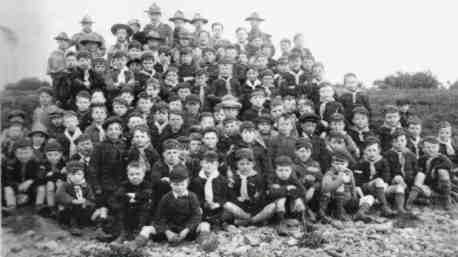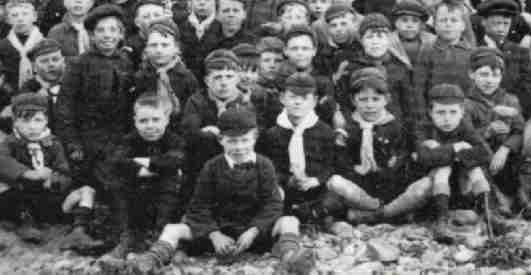
English Wolf Cubs

Figure 1.--This photograph shows what an early English Cub pack. Not all the boys wear the full uniform, but the boys that are in uniform wear a style which lasted for decades and influenced Cub uniforms all over the world. This was a Darlington pack photographed on the River Tess.
|
|
Cub Scouting began officially in England during 1916. Prior to that date
many younger boys participated unofficially in Scout troops, but in 1916 Wolf
Cubs were officially recognized as a younger section of the scouting movement.
Wolf Cubbing were for boys aged 7 to 11 years of age. There had been a growing
need for a special section for them as they were keen to join the Scouts but
were too young to join in the adventurous activities. Following the theme based on Kipling's Jungle Book, Wolf Cubs are organized into into groups of six boys (called a Six). (The term in America is a Den.) Sixes are organized into Packs which can include one or more Sixes. The Wolf Cubs were a
program especially geared for younger boys with their own distinctive uniform came officially into being.
The English Wolf Cub uniform remained essentially unchanged for many years.
It was very similar to scout uniform, the main differences being a cub cap
rather than a scout hat and a jersey rather than the scout shirt. At this time
shorts were commonly worn by boys of all ages, including scouts and indeed
their scoutmasters, and these were much favoured by Baden-Powell. Much of the
influence on scout uniform came from smarter schools, but scouting also
influenced school uniform where, for boys up to 11 in particular, shorts were
the norm until relatively recently.
Cubbing Created
Cub Scouting began officially in England during 1916. Prior to that date many younger boys participated unofficially in Scout troops. There was a set ager, but younger brothers often tagged along. And it was difficult to chase them away. It was clear that a program for the younger boys was needed. Baden Powell did not want to include them in the Scouting program because that would discourage older boys from particiapting. So in 1916 Wolf Cubs officially came into being and were officially recognized as a younger section of the British Scouting movement. This was just a few after the Scouting program was created. It would take American Scouts far longer to create a Cubbing program. Wolf Cubbing were for boys aged 7 to 11 years of age. There had been a growing need for a special section for them as they were keen to join the Scouts, but were too young to join in the adventurous activities. The Wolf Cubs were a program especially geared to the needs and interests of younger boys and provided with their own distinctive uniform.
Cubbing was created in 1916. The uniform was designed o be quite distinctive
from the Scout uniform. Often older boys do not want to be associated with
younger boys. Thus the Cub and Scout uniforms were purposefully meant to be
distinctive. The Cubs had a distinctive cap, green jumper grey shorts and grey
kneesocks. Many boys beginning in the 1920s wore sandals with their uniform.
The uniform has essentially remained the same for nearly a century. Minor
differences in the length of the shorts, type of knee socks, and footwear is all
that have differentiated Cubs through the 1980s. Hair styles of course also
varied. We know of no other Scout/Cub uniform that has remained unchanged over
such an extended period of time. Caps were dropped in the 1990s and increasing
numbers of Cubs wore long trousers.
English Wolf Cubs, following the theme based on Kipling's Jungle Book, are
organized into into groups of six boys (called a Six). (The comparable term in America Cubbing is a Den.) Sixes are organized into Packs which can include one or more Sixes. The name Pack comes from the term for a group or family of wolves. This fits into the Jungle theme because Mogali, the boy in Jungle Book, was raised by wolves. Cub Packs are normally linked to a Scout group supported by the same sponsoring organization and this provides for a seemless transition for the boys from Cubbing to Scouting. The Cub Pack is lead by Akela, the leader of the pack from the Jungle Book. The boy leader (typically the oldest) of the six Wolf Cubs in a Six is known as the "Sixer", and has two stripes on his sleeve. He is assisted by the "Assistant Sixer", who has one stripe on his sleeve. Youth Leaders from more senior sections of Scouting, normally a Boy Scout, are encouraged to assist as Cub Scout leaders. In Britain they were originally called Cub Instructors. They are now called Young Leaders. An important part of the Scouting program is to develop leadership skills and this is an opportunity to do just that.
Cubing activities often involved the parents, adult leaders, and friends of
Cub Scouts in largely home centered programs that teach a wide range of life
skills, values, and attitudes consistent with those of the the sponsoring
organization. Cubbing involved a wide range of activities. As it was for
younger boys the activities were more home based than Scouting activities. There were skills to learn
like knot tying. There were a variety of projects like model building. The
weekly pack meetings always had games which were very popular with the boys.
There might also be skits. Outings and field trips were an especially popular
activity. Cubbing activities are designed to encourage character development,
physical skill, family unity, and enjoyment of learning. English Cub program
based on Rudyard Kipling's book, Jungle Book. This was quite
different than the American program which for rather racist reasons was not
willing to embrace Africa and influenced by Seaton focused more on Indian Lore.
Gender
Cubbing began like Scouting as an all-boy activity. Guiding was at first even criticized for being too boyish. This continued to be the case for decades. Girls interested in youth group activities could join the Girl Guides which a Cub-like junior division--the Brownies. Beginning in the 1990s, some Cub Packs began allowing girls to participate informally. We note a good example at a Pack event. Notice how the girls are staying togetger. This had involved several trends, including coeducation in the schools. Some intrpid girls found the more active Cub program appealed to them more than the more sedate Brownie program. More often it was often a matter of family scheduling. Having to cart kid around to the events of two organizations, was much more complicated than just dealing with one organization. This was particularly true when Akela had both sons and daughters. What began informally was eventually recognized by the national organization. Girls can now officially participate in both Cubbing and Scouting at all levels. Many girls, however, prefer the all-girl Brownies and Guides which continue to function and as far as we know do not permit boys to join or at least boys are not prone to do so.
Baden Powell chose a theme based on Kiplings Jungle Book, it proved
wildly popular with the boys--even if it is now often made fun of in our more
cynical age. The English Cub uniform spread around the world. Some countries
used it virtually unchanged. Others like America changed it significantly. One
constant in most countries was the Cub cap, just as Scouts in most countries
used the original Scout hat for decades. The uniform adopted for English Cubs
in 1916 was worn by English boys for decades virtually unchanged. It was
adopted by Cubs all over the world although it was gradually modified and
changed. In England, however, it has continued virtually unchanged. The only
major change has been in the pants and knee socks the boys have worn. The Wolf
Cubs began operating in 1916. The uniform designated for Cubs in 1916 was worn
by English boys for decades virtually unchanged. It was subsequently adopted by
Cubs all over the world although it was gradually modified and changed. In
England, however, it continued virtually unchanged.
Scouts and Cubs have their own special salutes and handshake. The Cubs salute
with two fingers rather than with all five fingers as in a military salute. The
hand shake is the famous left hand shake. The same conventions are used by
Scouts around the world. These are some of the first things a new Cub learns.
Wolf Cubs often participate in events with Boy Scouts and Sea Scouts. Sometimes the Wolf Cubs shared a common chartering institution and sometimes they participated in the same parish or neighborhood. Thus there are a range of common bonds between the Cubs and Scouts. In recent years church sponsorship has become increasdiongly important which has increased the level of common events. Often brothers of different ages are involved and parents are often involved at different levels, often mums with the Cubs as Akela and dad's with the Scouts. The same is true of the Guides. Although the Guides traditionally had a separate organization, they often have the same chartering organization. This means that they may share facilities like the Scout Hut and fund raising events like Gymkhanas, Scout Band competitions, and many others.
HBU

Navigate the Historic Boys' Uniform Chronology Pages:
[Return to the Main chronologies
page]
[The 1900s]
[The 1910s]
[The 1920s]
[The 1930s]
[The 1940s]
[The 1950s]
[The 1960s]
[The 1970s]
[The 1980s]
[The 1990s]
[The 2000s]
Navigate the Historic Boys' Uniform Web Site:
[Activities]
[Biographies]
[Chronologies]
[Countries]
[Essays]
[Garments]
[Organizations]
[Religion]
[Other]
[Introduction]
[Bibliographies]
[Contributions]
[FAQs]
[Questions]
[Unknown images]
[Boys' Uniform Home]
Navigate the Historic Boys' Uniform Web organization pages:
[Return to the Main English Scout page]
[Return to the National Scout page]
[Boys' Brigade]
[Camp Fire]
[Hitler Youth]
[National]
[Pioneers]
[Royal Rangers]
[Scout]
Created: November 15, 1998
Last updated: 1:29 AM 10/7/2013




